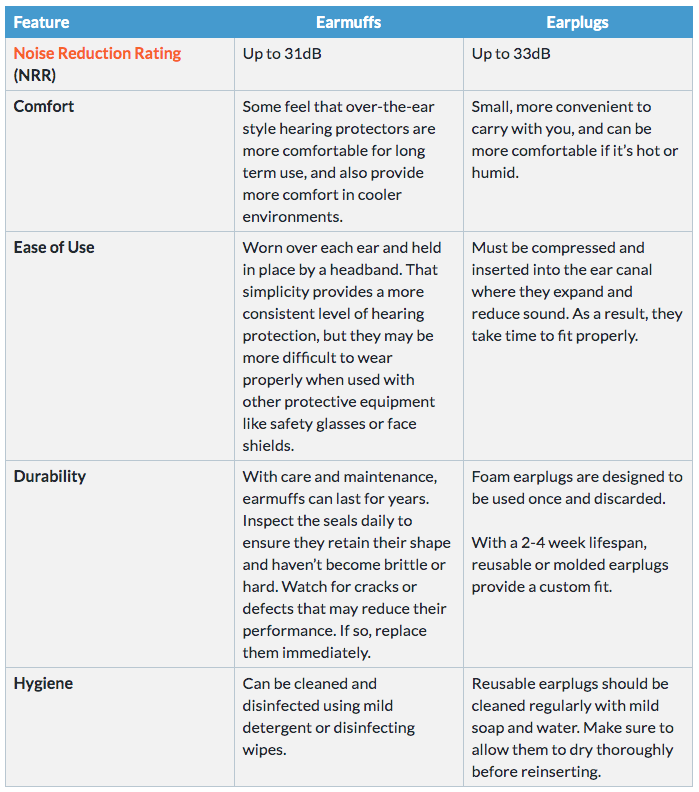Interested in Trucks?
Get Trucks articles, news and videos right in your inbox! Sign up now.
Trucks + Get AlertsHearing protectors are often required to keep you safe from dangerous noise levels and today’s hearing protection devices offer a lot of options to choose from: noise reduction ratings, ease of use, form factor, comfort, durability and how easy they are to clean and disinfect.
Noise levels on a municipal job site vary based on the task and the type of equipment in use. And since crews often work within shouting distance, the racket from nearby machinery adds to the sounds produced by your own tools and tasks. And all that noise will take a toll.
Here are the important things to consider when selecting your next safety solution.
Do you need a hearing protector?
If you’ve been working around loud equipment for a while, you may feel that the noise they create is “normal.” However, your ears never get used to loud noise. According to the Centers for Disease Control, “Hearing loss progresses as long as the exposure continues. Harmful effects might continue even after noise exposure has stopped.”
But suppose the noise you deal with isn’t constant. “I don’t hear it all the time, so it’s not as bad.” Unfortunately, even occasional exposure to loud noise during the day — when repeated day after day, week after week — can cause hearing damage and permanent hearing loss.
OSHA requires employers to have a hearing conversation program in place if workers are exposed to a time-weighted average noise level of 85 decibels or higher over an eight-hour work shift. To put that in perspective, normal conversation is about 60 dB, and vehicles, power tools and heavy equipment routinely average 95-100 dB. That’s well above the OSHA 85 dB threshold.
How loud is the job site?
You may have a noise problem if:
- Noise is louder than heavy city traffic.
- You have to raise your voice to talk to someone more than 3 feet away.
- You hear a ringing or humming in your ears when you leave work.
- You must increase the volume on your TV, phone or other media devices to the point that others complain.
- You have difficulty hearing and understanding conversation when there are other sounds or many voices in the background.
The first step in deciding if you need to wear a hearing protector is assessing the level of noise you’re being exposed to. There are a few ways to go about this:
- Walk around the site and listen to noise levels in areas where you work. Can you hold a conversation without shouting or moving closer to the other person?
- Use an app to get an informal idea of how loud it is when you’re operating different types of equipment and at different places in the work zone. The National Institute of Occupational Safety and Health’s Sound Level Meter has one option.
- Your employer may also be taking official measurements of sound levels using equipment designed for the job, such as level meters and noise dosimeters.
Comparing hearing protectors
There are two basic types of hearing protectors: in-ear or earplug style, and over-the-ear or earmuff style. Each type has its advantages and disadvantages. But both are designed to reduce the amount of sound that reaches your ears.
Now that you know you need a hearing protector, here are some things to keep in mind when comparing choices.
Noise reduction rating (NRR) If your job site’s noise level requires a reduction of 20 dB for safety, an NRR rating of 20 dB or higher on an HPD is high enough to provide the protection you need. If you experience occasional impulse noises that are louder, look for a higher NRR rating to cover those spikes.
“Doubling up” your protection Wearing both earplugs and earmuffs together can provide an extra 5 dB of noise reduction rating. There’s some math behind the calculations, but you don’t simply add the second hearing protector’s NRR rating to the first. NIOSH recommends that anyone whose time-weighted average noise exposure exceeds 100 dB over an eight-hour shift wear both types of hearing protectors simultaneously.

Ultimately, the right hearing protector for you is the gear that you’ll wear consistently. If you compromise there, you’re likely to find yourself leaving them in the equipment shed or the truck, rather than wearing them when you need them most.
Taking it to the next level
Hearing protection is critical for safety. But what about communication? Earplug and earmuff-style hearing protectors cut out most noise, including the voices of your crew, the sounds of nearby vehicles and the warning alarm of an overheating engine. Do you pull out your earplugs or pull off an earmuff to be able to hear? Now you’re right back where you started.
Sonetics specializes in combining hearing protection with the productivity benefits of wireless communication. To learn more, visit Sonetics’ Team Systems page.






